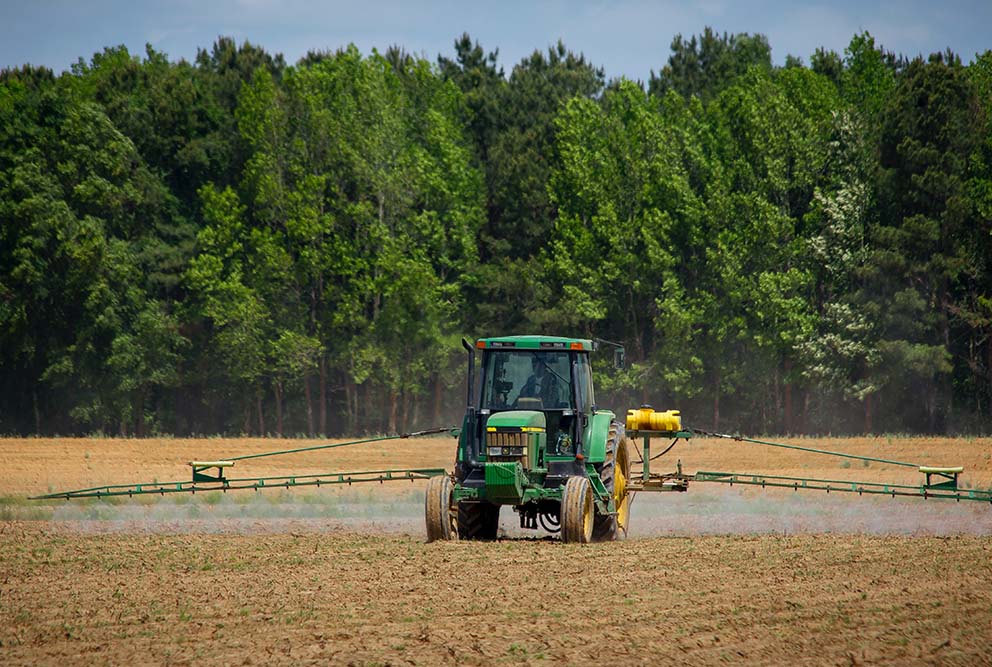Your Cart is Empty
December 15, 2021 3 min read

It should come as no surprise to hear that pesticides are dangerous if consumed. People already know this–they wash their grapes before eating them and don’t bite into a carrot straight upon arrival home from the supermarket. However, it is less well known what pesticides do to the body or which chemicals people are exposed to. Atrazine, a type of weedkiller, leaks into water supplies across the U.S. and puts households at risk of its harmful effects. Without a proper water filter, atrazine will continue to be consumed unknowingly by the American public. But what exactly is atrazine?
Atrazine is a pesticide, most commonly used to kill weeds for agricultural purposes, but it is also used to treat residential lawns, turf, and golf courses. Each year, the United States uses over seventy million pounds of the chemical, and its popularity makes it easy to slip into water supplies. Once consumed, a wide variety of health defects, especially concerning children and expecting mothers, can arise. To protect oneself from the harmful effects of atrazine, experts suggest getting water tested or using a water filter that will filter out harmful pollutants like atrazine.
The pesticide is commonly used in agricultural areas, and currently nineteen states (affecting 7.6 million Americans) detected atrazine above the health-protected guidelines in their public water supplies. Atrazine defects remain an understudied problem, and those numbers are projected to grow as more areas are tested. When the weedkiller is used, the soil does not absorb it well, so irrigation systems or rainfall pick up the chemical and take it into groundwater supplies. Environmental engineer Raj Rathak notes that traces of atrazine “may be washed from the soil by rainfall and enter surrounding areas including streams, lakes, or other waterways and [it] may migrate from the upper soil surface to deeper soil layers and enter the groundwater.”
Once in the water supply, drinking tap water leads to the potential for all sorts of health problems related to atrazine. The most commonly cited effect of the pesticide is hormone alteration in women, lowering estrogen levels and irregulating menstruation. Both these characteristics are directly linked to fertility. Additionally, ovarian, breast, and uterine cancers and birth defects to fetuses are all linked to the inadvertent consumption of atrazine. Annually, over 50,000 children experience pesticide poisoning, and 3,000 experienced childhood cancer, neuroblastoma, and other serious diseases.
Despite dreadful health effects, there is an easy way to protect oneself from atrazine consumption. Water filters, like those found at Seychelle, can ensure even tap water is safe to drink. Seychelle water filters are third-party tested and filter out pesticides like atrazine, which allows households to enjoy their water supply risk-free.
Frequently Asked Questions
What is atrazine?
Atrazine is a pesticide commonly used to kill weeds. It is widely popular in the United States in agricultural fields, but it is also used to treat golf courses and residential lawns. Its popularity allows for the pesticide to perpetrate both rural and residential areas.
How does atrazine enter the water supply?
Atrazine has a relatively long half-life, meaning it does not just absorb into the ground and go away. Instead it stays in the soil, and when it rains, the rain takes it into groundwater supplies, lakes, and streams. From there, it enters households through tap water.
How can I protect myself from atrazine poisoning?
Atrazine poisoning can be avoided by consuming only clean water. In order to do so, investing in a water filter from Seychelle allows all atrazine traces to be filtered out, ensuring clean drinking water.
Works Cited
“Get Informed: What is Atrazine?” Know Your H2O Water Research Center, 2021,https://www.knowyourh2o.com/indoor-6/atrazine. Accessed 13 December 2021.
Konkel, Lindsey. “Atrazine in Water Tied to Hormonal Irregularities.” Scientific American, 28 November 2011,https://www.scientificamerican.com/article/atrazine-water-tied-hormonal-irregularities/. Accessed 13 December 2021.
Naidenko, Olga. “Atrazine: A Harmful Weedkiller Taints Tap Water for Millions in U.S.” EWG, 29 August 2017,https://www.ewg.org/news-insights/news/atrazine-harmful-weedkiller-taints-tap-water-millions-us. Accessed 13 December 2021.
Pathak, Raj K., and Anil K. Dikshit. “Atrazine and Human Health.”International Journal of Ecosystem, vol. 1, no. 1, 2011, pp. 14-23.